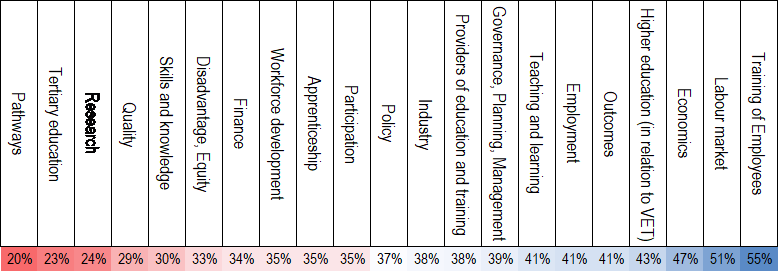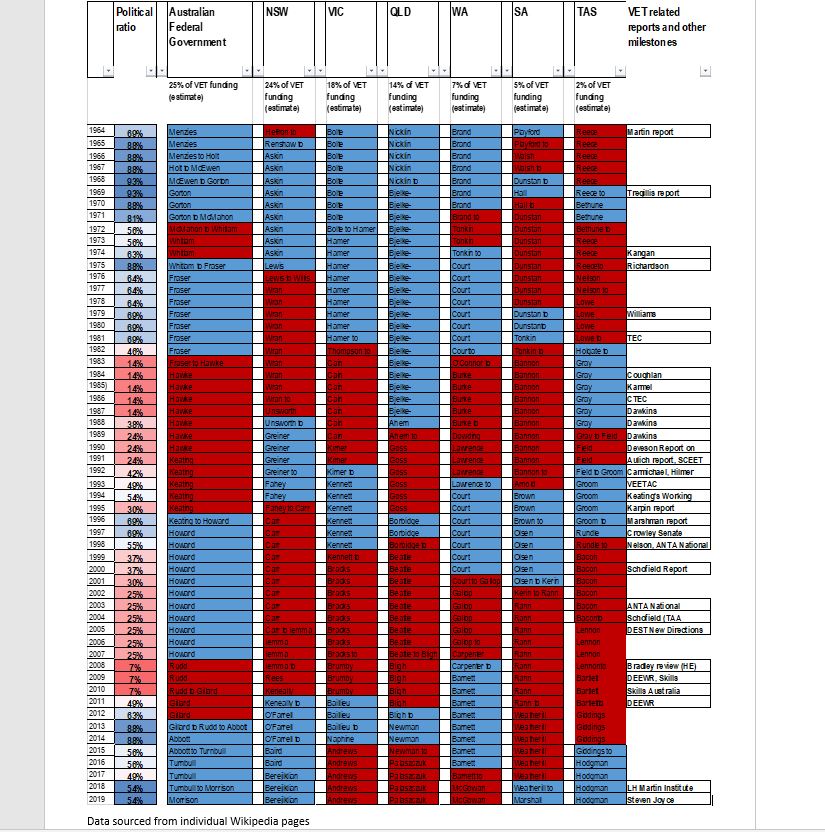A surge of reports on the future of Australia’s VET sector were published in the lead-up to the federal election, many tabled by Craig Fowler in a recent article published in Campus Review. Labor’s Tanya Plibersek established the terms of reference for her party's proposed National Inquiry into Post-secondary Education in Australia. In response, the Morrison government commissioned Steven Joyce to provide his Expert Review of Australia's Vocational Education and Training System.
The outcome of the federal election has left questions unanswered regarding the political appetite for VET reform in Australia. It may be too early to predict what Senator Michaelia Cash (the newly appointed Minister for Small and Family Business, Skills and Vocational Education) plans to do, but predictably the potential role of VET and jobs will be high on the agenda. However, responsibility for VET is distributed among federal and state governments, hence COAG negotiations will play a significant role in the scope of any reforms.
Realistically, what could be the scope of such negotiations? One way of framing such discussions is to look through an 'Overton window', a political theory that refers to the range of policies that an electorate or politician will accept. To put such plans in a historical perspective, this analysis aims to create a bird’s eye view of Australia’s VET tracing back to 1964.
This Overton window of Australia’s VET is based on a thematic analysis of two related data sets. The first data set compares the subject codes of 55 reports relating to Australia’s VET, tracing back to 1964 sourced from the National Centre for Vocational Education Research (NCVER). The selection of these publications was guided by Hugh Guthrie, a veteran researcher in VET who has worked for the NCVER for many years.
It is hypothesised that the subject codes linked to VET-related reports indicate the zeitgeist of the time in which they were published. These subject tags are matched to a second data set that quantifies the predominant political colour in a given year. This measure is based on a calculation of where the political pendulum ranks in individual federal and state governments from 1964 to 2018.
For the purpose of this Overton window, it is estimated that on average the Australian government provides 25 per cent of VET funding, NSW 24 per cent, Victoria 18 per cent, Queensland 14 per cent, Western Australia 7 per cent, South Australia 5 per cent and Tasmania 2 per cent.
When that data is compared with the list of subjects of reports written in that particular year, political pendulum swings can be revealed that underpin policy decisions in VET. So, the political zeitgeist starts with predominantly ‘blue’ federal and state governments from 1964 onwards. Then, red and blue pendulum swings mark changes in the political zeitgeist influencing VET.
The resulting Overton window shows what report subjects could be considered more ‘centre forward’ politically speaking. Subjects leaning to the left of the table are more prevalent in reports published during times when Labor is in power. Subjects leaning to the right of the table are dominant themes when the Coalition is in power.
The most prevalent subject (mentioned 28 times in the 55 reports included in this analysis) is Governance, Planning and Management. This subject is, politically speaking, in the middle of the Overton window, hence can be considered a ‘broad spectrum’ theme.
On this political spectrum, subjects listed on the left appear mostly in more Labor-dominated political years. For example, the subject of Pathways tends to come with political trade-offs in terms of costs and benefits. Pathways typically challenge the exclusivity of higher education, so become part of the democratisation of tertiary education.
During more Liberal dominated years, the subject of Higher Education is included in reports, but more likely in the sense of keeping VET and higher education systems separate. To illustrate these different approaches, Tanya Plibersek proposed a ‘post-secondary’ inquiry, whereas the Joyce Review kept the scope of the review within the boundaries of the VET system.
Another political contrast illustrated in the Overton window is the subject of Skills and knowledge versus Outcomes. The political contrast between these two subjects was made evident in the mid-1990s when the political decision was made to take knowledge largely out of Training Packages. While few would argue the importance of focusing on outcomes, politically this impacts on the focus of VET. As Pauline James noted in 2010, this positioned the role of VET in developing procedural, technical workers, rather than reflective problem-solvers and innovators. A current review of the AQF is reconsidering the role of knowledge in AQF levels 5 and 6 in particular.
Historically, VET reports that include the subject of Apprenticeships generally appeared more in Labor contexts. Now that the Morrison government has clustered VET in the same portfolio as small and family business, this may reframe political perspectives on apprenticeships as a means of offering financial support to small and family business.
As can be seen in the table below, Australia’s VET operates in steadily changing political contexts. One notable illustration of such political pendulum swings happened in 1997, when the Howard government found itself aligned politically with every state government except NSW. This political swing saw the number of private RTOs increase from 900 to 4500. This was also the time when the controversial BSZ40198 Certificate IV in Workplace Training and Assessment set bold new thresholds for teacher training.
If funding remains a shared responsibility, COAG negotiations relating to VET will need to be acceptable to the Australian government, three Labor and three Liberal state governments. This time, there will be no shortage of recommendations, but time will tell what the scope of reform will be on the Overton window.
 Hans Tilstra is an education professional with 20+ years of experience in the pedagogical connections between industry, VET and university. Having worked in three Victorian TAFEs as well at the dual sector RMIT, Hans witnessed first-hand the impact of political changes on service delivery. In 2018 he helped catalyse development of an informal network of VET experts, aiming to capture hard-earned lessons of VET’s past, in order to come up with progressive recommendations. This network co-authored a series of articles published by Melbourne University.
Hans Tilstra is an education professional with 20+ years of experience in the pedagogical connections between industry, VET and university. Having worked in three Victorian TAFEs as well at the dual sector RMIT, Hans witnessed first-hand the impact of political changes on service delivery. In 2018 he helped catalyse development of an informal network of VET experts, aiming to capture hard-earned lessons of VET’s past, in order to come up with progressive recommendations. This network co-authored a series of articles published by Melbourne University.
Hans can be contacted on LinkedIn and Twitter (@HTilstra).
Do you have an idea for a story?Email [email protected]
 Campus Review The latest in higher education news
Campus Review The latest in higher education news



